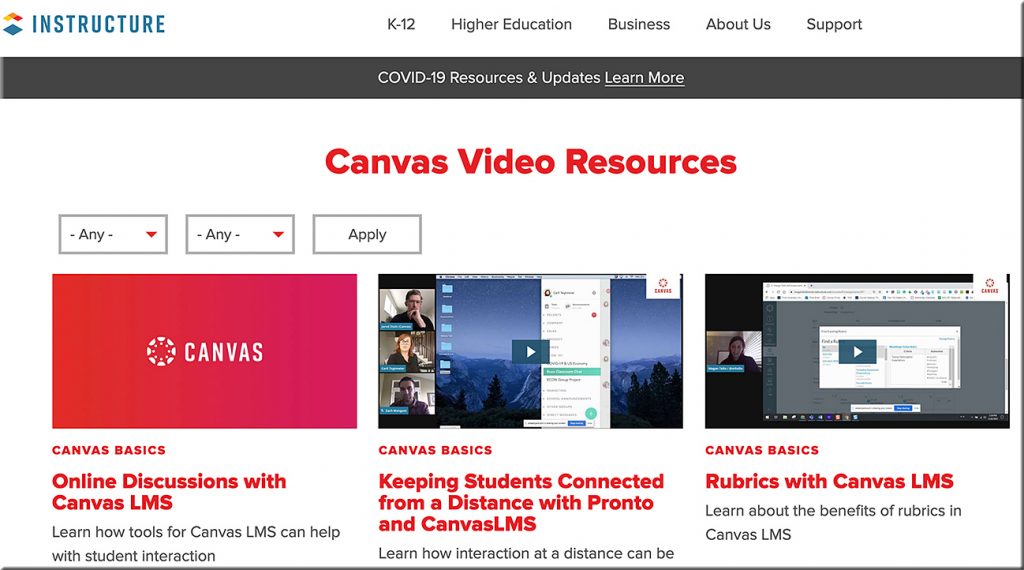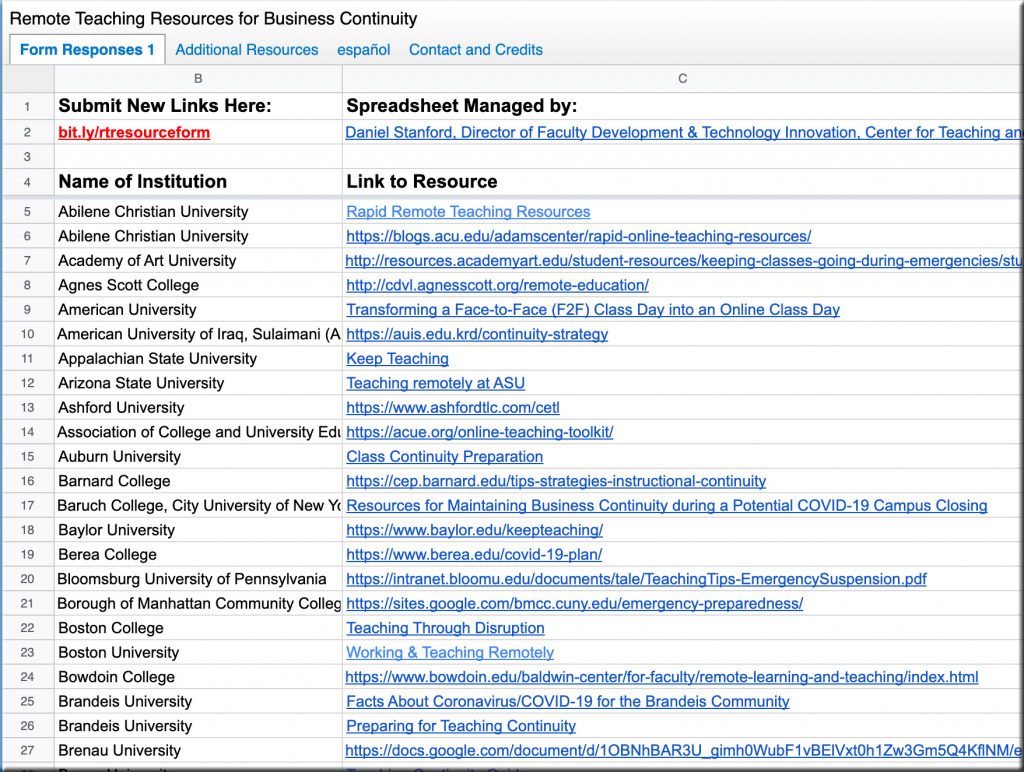From DSC:
I don’t think Karl would mind if you posted a link to his video in your Week #1 module…
…and/or in your online orientation sessions, etc.
Thanks Karl for posting this resource out there on YouTube!




4 items on Instructure’s to-do list after the sale of the Canvas LMS provider — from edsurge.com by Wade Tyler Millward
Excerpt:
Even without a pandemic, Instructure faced a transformative 2020. The learning management system provider—best known for its Canvas product popular among colleges—is officially under private equity ownership.
5 easy ways to infuse learning science into remote teaching — from campustechnology.com by Andrea Hendricks
These practices will help engage students and improve outcomes throughout the online learning process.
Excerpt:
Here again, good organization is essential. I organize my content by units that are aligned to tests, so my students always have a clear learning goal in mind. If I have six tests in a semester, I divide the content into six units. Each unit contains an overview for the module, a submodule for each section, a review of the key concepts from the unit, a set of review problems for the unit, and a test. Within section submodules, I give an overview of the objectives, activities for students to engage with and learn the content (reading assignments, videos, animations, homework problems), and a discussion question. I also include modules on getting started with the course, the technology we’ll be using as well as tutoring information and resources.
From DSC:
On the positive side…
What I appreciate about John Villasenor‘s article is that it’s asking us to think about future scenarios in regards to higher education. Then, it’s proposing some potential action steps to take now to address those potential scenarios if they come to fruition. It isn’t looking at the hood when we’re traveling 180 mph. Rather, it’s looking out into the horizon to see what’s coming down the pike.
6 Steps to Prepare for an Online Fall Semester — from chronicle.com by John Villasenor
Excerpt (emphasis DSC):
Plan for a multiyear impact. If colleges are forced to maintain online-only instruction in the fall and to defer reopening their campuses to in-person instruction to January 2021, the impact will be felt for years. College leaders should start thinking now about how to manage and potentially adjust spring-2021 (and beyond) course offerings, course sequencing, and degree requirements to avoid saddling students with graduation delays and the accompanying direct and indirect financial costs. In addition, colleges should anticipate a smaller-than-normal entering first-year class in fall 2020 (and thus a larger-than-normal enrollment a year later) and devise strategies to help mitigate the resulting stresses on admission rates and classroom and dorm capacity for first-year students entering in fall 2021 and beyond.
If instruction remains online-only in the fall, colleges won’t be able to afford that sort of inefficiency. College departments should start now to identify opportunities for collaborations that would draw on the collective wisdom and labor of faculty members from multiple institutions who are teaching similar courses. This would lessen the burden of migrating teaching materials and techniques to an online format.
From DSC:
I’ve often wondered about the place of consortiums within higher ed…i.e., pooling resources. Will the impacts of the Coronavirus change this area of higher ed? Not sure. Perhaps.
On the negative side…
I take issue with some of John’s perspectives, which are so common amongst the writers and academics out there. For example:
Conversely, an entire generation of current college students is now learning that it can be pretty boring to be one of several hundred people simultaneously watching a Zoom lecture.
You know what? I did that very same thing — over and over again — at Northwestern University (NU), but in a face-to-face format. And quite frankly, it’s a better view on videoconferencing. It’s far more close up, more intimate online. I agree it’s a different experience. But our auditoriums were large and having 100-200+ students in a classroom was common. There was no interaction amongst the students. There were no breakout groups. The faculty members didn’t know most of our names and I highly doubt that the well-paid researchers at Northwestern — who were never taught how to teach in the first place nor did they or NU regard the practice of teaching and learning highly anyway — gave a rat’s ass about body language. Reading the confusion in the auditorium? Really? I highly doubt it. And those TA’s that we paid good money for? Most likely, they were never taught how to teach either. The well-paid researchers often offloaded much of the teaching responsibilities onto the teacher assistants’ backs.
Bottom line:
Face-to-face learning is getting waaaay more credit than it sometimes deserves — though sometimes it IS warranted. And online-based learning — especially when it’s done right — isn’t getting nearly enough credit.
Addendum: Another example of practicing futures thinking in higher ed:
Q: For those who prefer or need to handwrite their essays, what are some ways/methods that students can use to scan in — and then submit — their essays into Canvas?
A: Below are a few different options, potential solutions, and resources:
Also see:
Why education is a ‘wicked problem’ for learning engineers to solve — from edsurge.com by Rebecca Koenig
Excerpts (emphasis DSC):
So, back to the wicked problem: How do we make education that’s both quality education and at the same time accessible and affordable?
“Now, we are building a new technology that we call Agent Smith. It’s another AI technology— and we’re very excited about it—that builds [a] Jill Watson for you. And Agent Smith can build a Jill Watson for you in less than 10 percent of the hours.”
…
So one question for online education is, can we build a new set of tools—and I think that’s where AI is going to go, that learning engineering is going to go—where AI is not helping individual humans as much as AI is helping human-human interaction.
Huge ethical issues and something that learning engineering has not yet started focusing on in a serious manner. We are still in a phase of, “Look ma, no hands, I can ride a bike without hands.”
…
Technology should not be left to technologists.
Homeschooling During the COVID-19 Pandemic — from cato.org by Kerry McDonald
Excerpt:
In a recent three-part Cato Daily Podcast series, I spoke with host Caleb Brown about this unprecedented educational moment, including sharing strategies and resources for overcoming the challenges of unexpected, unchosen homeschooling, as well as possible outcomes as more parents seek alternatives to conventional schooling post-pandemic.
More Free Resources For New Homeschoolers — from forbes.com by Nick Morrison
Excerpt:
Last month I highlighted some of the free resources available for parents — and teachers — during the pandemic, but since then a number of other organizations have offered their resources, expertise and support for free, so here is another selection, for the benefit of ordinary homeschoolers in these extraordinary times.
From DSC:
Below are excerpts from a recent email that I received as a cc: to our son and am passing it along in case it helps others out there.
I would like to share with you important guidance on how to get the most out of your online learning experience.
ORGANIZING YOUR SPACE
Set up your home classroom space. This is important. Be sure you have a space that is comfortable and where you can focus on your studies, your practice, your craft and your learning. This can be private or shared, whatever works for you and your family.
WHAT YOU WILL NEED
SCHEDULE
You will complete your work and engage in your lessons in two ways. Some assignments are laid out in your Canvas class and can be completed at your own pace, turning work in when due. And some of your classes and lessons will require you to connect with faculty and students in real time. When a real-time option is possible, be sure to take it.
STAYING CONNECTED
Again, be sure to connect in real time as often as possible. There are lots of opportunities to connect with faculty and students every day.
…
Join in as many real time experiences as you can. These human connections, across the internet, are so important during this time when we are all separated physically.
NORMS FOR VIDEO-CONFERENCING
SUMMARY OF STUDENT RESPONSIBILITIES
Under the Table and Teaching: 11 Expert Tips for Schooling Kids with ADHD from Home — from additudemag.com
Unschooling. Homeschooling. Crisis schooling. What is the difference? And what are the best learning strategies for your child with ADHD at this stressful time? Here are tips and strategies from education experts who understand the distinctions and today’s inescapable realities.
Excerpts:
11 Ways to Support Learning at Home
Research Quest Live sign up
Though the museum is currently closed, the Natural History Museum of Utah is allowing kids around the globe the opportunity to transport back in time to a past where dinosaurs roamed the world. With the recently launched Research Quest Live, offering a taste of the world with virtual tours and free access to daily online science classes taught by museum educators.
Common Sense Launches Wide Open School to Help Families and Educators Transition to Students Learning from Home — from commonsensemedia.org
As Schools Continue to Close as a Result of the Coronavirus Pandemic, Some of the Most Respected Companies in Education, Media, and Tech Join Forces to Offer a Free and Open Collection of Quality Online Learning Resources to Educators and Families.
Excerpt:
SAN FRANCISCO, March 31, 2020—Common Sense, the leading nonprofit organization whose mission is to help kids, families, and educators thrive in a world of media and technology, has convened a group of education, media, and tech partners to launch WideOpenSchool.org, a free online resource to support families and educators who are transitioning to remote learning as a result of the coronavirus.
Wide Open School features the very best resources from publishers, nonprofits, and education companies, including the American Federation of Teachers, Amplify, Boys & Girls Clubs of America, Head Start, Khan Academy, National Geographic, Noggin, PBS, Scholastic, Sesame Workshop,Time for Kids, XQ Institute, and YouTube. Find the full site at WideOpenSchool.org.
Canvas Video Resources — from instructure.com
Are you in the middle of #remotelearning, and could you use a refresher on how to do certain things w/Canvas LMS? Don’t worry, a group of community members came together & produced videos about key features to help you get moving.

#edtech #onlinelearning #coronavirus #education #highered #k12 #CMS #LMS #Canvas
COVID-19 Resources for Higher Ed — from EDUCAUSE
With the help of the higher ed community, EDUCAUSE continues to compile resources to help you manage the implications of COVID-19, including information on working remotely, online education, campus advisories, and higher ed continuity planning and emergency preparedness.
The Chronicle of Higher Education
Also see:
From DSC:
I’d like to thank Mr. Eric Osterberg — a fraternity brother and friend of mine — for sending me the following article. I wrote back to him. After thanking Eric for the article, I said:
Such an article makes me reflect on things — which is always a good thing for me to try to see my blindspots and/or to think about the good and bad of things. Technologies are becoming more powerful and integrated into our lives — for better at times and for worse at other times.
I’m wondering how the legal realm can assist and/or help create a positive future for societies throughout the globe…any thoughts?
Can computers ever replace the classroom? — from theguardian.com by Alex Beard
With 850 million children worldwide shut out of schools, tech evangelists claim now is the time for AI education. But as the technology’s power grows, so too do the dangers that come with it.
Excerpts:
But it’s in China, where President Xi Jinping has called for the nation to lead the world in AI innovation by 2030, that the fastest progress is being made. In 2018 alone, Li told me, 60 new AI companies entered China’s private education market. Squirrel AI is part of this new generation of education start-ups. The company has already enrolled 2 million student users, opened 2,600 learning centres in 700 cities across China, and raised $150m from investors.
…
The supposed AI education revolution is not here yet, and it is likely that the majority of projects will collapse under the weight of their own hype.
The point, in short, is that AI doesn’t have to match the general intelligence of humans to be useful – or indeed powerful. This is both the promise of AI, and the danger it poses.
It was a reminder that Squirrel AI’s platform, like those of its competitors worldwide, doesn’t have to be better than the best human teachers – to improve people’s lives, it just needs to be good enough, at the right price, to supplement what we’ve got. The problem is that it is hard to see technology companies stopping there. For better and worse, their ambitions are bigger. “We could make a lot of geniuses,” Li told me.
Moving to remote instruction immediately: Where to get started — from thejournal.com by Dian Schaffhauser
To help schools make the transition as quickly and comprehensively as possible, THE Journal reached out to education technology experts across the country to answer the questions we believe nearly every educator is rushing to answer right now.

From DSC:
Due to the impacts of the Coronavirus, learning ecosystems across the globe are going through massive changes!
Each of us has our own learning ecosystem, and the organizations that we work for have their own learning ecosystems as well. Numerous teachers, professors, and trainers around the world are now teaching online. Their toolboxes are expanding with the addition of several new tools and some new knowledge. I believe that will be one of the silver linings from the very tough situations/times that we find ourselves in.

At the WMU-Cooley Law School, our learning ecosystem is also fluid and continues to morph. This blog posting speaks to those changes.
Learning from the Living [Class] Room: Due to the impacts from the Coronavirus, this is happening today across many countries. But this vision is just beginning to develop. We haven’t seen anything yet.
Sustaining Higher Education in the Coronavirus Crisis — from edsurge.com
Excerpts:
Online teaching tools and plans: A directory of websites set up by colleges to help their campus move teaching online, by the POD Network.

Also related/see:
Adjusting to emergency online instruction poses extra challenges for adjunct faculty — from edsurge.com by Rebecca Koenig
Contract, part-time and contingent faculty members face extra challenges when trying to move their classes online due to the coronavirus. Adjuncts may not get paid for the extra work the shift requires and may lack adequate access to necessary technology tools and training. They also have health concerns to consider, since they usually don’t get paid sick days or health care benefits from their college employers.
“We accept transfer credit for students, why don’t we accept transfer courses for adjuncts?” Andersen says. “I wish there was more equity around it. I wish adjuncts had the same access to teaching online as full-time faculty. We would better off in this crisis right now if they did.”
Some of these concerns are addressed in the COVID-19 response principles that the American Federation of Teachers and the American Association of University Professors issued on March 13 to guide colleges.
From DSC:
With a shout out to a colleague of mine for these resources:
DC: This hits home to the world I live in…big time! What a riot! I appreciate this faculty member’s sense of humor and his love of music too!https://t.co/RXaEkAIlCi
— Daniel Christian (@dchristian5) March 19, 2020
Also see:
This cracks me up too!https://t.co/LvISVTr0EK
— Daniel Christian (@dchristian5) March 19, 2020
Coronavirus has led to a rush of online teaching. Here’s some advice for newly remote instructors — from edsurge.com by Jeff Young & Bonni Stachowiak
Excerpt:
The simplest way to go online is to shift to a video conference platform
Stachowiak says that just lecturing to a webcam instead of an in-person class isn’t the best way to teach online, but it is the easiest way to switch. Under the circumstances, it is better than nothing. “I’d rather that you do that for your students, for yourself than to cancel all the classes,” she argues.
Think shorter
If it’s hard to hold students’ attention in person, it’s even harder online, says Stachowiak: “You’ll want to think about shortening that experience. The online environment tends to have shorter, more-compact opportunities and then other things to do that are more engaging than just sitting and listening.”